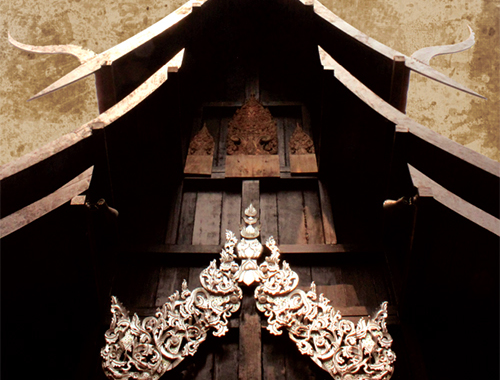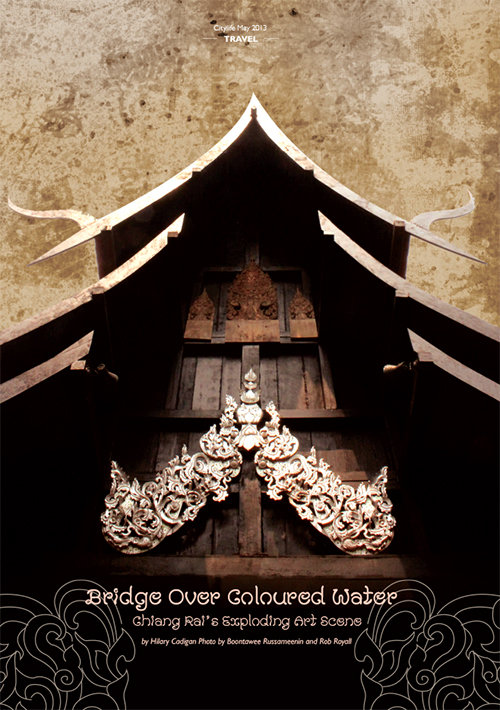
Chiang Mai’s little sister, Chiang Rai, long known as little more than a backwater base for trekking, is ready to show the world its true colours – a whole artful mix of them, in fact.
The city is in the process of establishing itself as a booming community of the arts, one that seems to have harnessed the perfect mix of small-town camaraderie and growing global attention. With its trifecta of colour-coordinated art landmarks (artmarks?) – Chalermchai Kositpipat’s White Temple, Thawan Duchanee’s Black House and Somluck Pantiboon’s Red Clay Hills – Chiang Rai is becoming increasingly well-known as a major tourist destination, with the potential for much more. But perhaps what is particularly great about the little Golden Triangle gateway is its stubborn refusal to sell out. What is emerging at the core of Chiang Rai is more organic and community-based than the typical winner-takes-all tourism grab of big sister Chiang Mai. Indeed, something very special is happening there. So, Citylife’s editors piled into a car and embarked upon the admittedly easy two-ish hour drive north from Chiang Mai to experience Chiang Rai’s homegrown art fever firsthand.
White, Black and Red
Our first stop on arrival was National Artist Chalermchai Kositpipat’s Wat Rong Khun, or White Temple, Chiang Rai’s best-known draw and a truly stunning sight. The brilliantly, blindingly white structure swathed in tiny mirrors and intricate carvings represents heaven, but must be reached by crossing a bridge over the pits of ‘hell’ (an eerie expanse of hands reaching up to grab you). Inside, a huge colourful mural depicts a motley scene of modern events mixed up with pop culture heroes and villains: a devil with Osama Bin Laden and George Bush in his eyes watches New York City’s Twin Towers burn while Spiderman perches helplessly nearby. It’s a tourist attraction for sure, but also a piece of endlessly fascinating art-in-progress, which Chalermchai claims will not be completed until 60 to 90 years after his own death. Most tellingly of all, it’s free to enter (even the gold palace of a bathroom, which is definitely worth saving a baht-free pee for), despite the fact that Chalermchai could easily be reeling in the dough from countless sightseers that visit each day.
Next up, Baan Dum or the Black House. The ‘hell’ to Rong Khun’s ‘heaven’ is also free to enter, and even more eerily fascinating than its counterpart. It also happens to be the home of its creator, world-renowned Chiang Rai born artist Thawan Duchanee. Off the beaten path and surprisingly void of visitors, the seemingly endless grounds are littered with strange and macabre sights – thousands of animal skins and skeletons arranged into eerie designs inside and around a series of dark structures, from ornate black and gold temples to igloo-like domes to an odd metal submarine-like edifice with the ears and eyes of a robotic elephant (or duck, or something). Gigantic live snakes rest in an outdoor cage while snake skins line tables inside the main hall, seemingly prepared for some kind of ghoulish underworld banquet.
A little dazed, we then made our way to the Red Clay Hills or Doy Din Dang, where Japanese-trained Chiang Rai native ceramist Somluk Pantiboon has set up his own personal workshop, gallery and cafe. Amidst the red clay lateral ridges, rolling jade hills and distant azure mountains that surround Chiang Rai, friendly Somluck and his lovely Japanese wife Tomako live and work, greeting guests and teaching classes to nearby villagers interested in learning the art of hand-thrown pottery using natural resources.
Indeed, it is Somluck’s undying passion for both art and his hometown that have led him to co-found Chiang Rai’s latest art addition (ardition? Okay, sorry). The Chiang Rai Art Bridge is a unique new artist’s collective and community centre that just so happened to be opening its doors that very weekend. We were able to attend the vibrant event, along with Chalermchai, Thawan, Somluck, Tomako and a slew of other artists and art aficionados (artaficio…right, will stop now) both local and foreign, to see what this new project was all about and what it meant for Chiang Rai’s citizens and visitors alike.
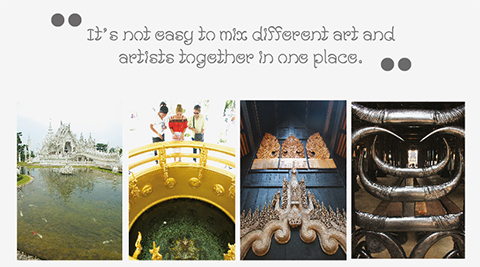
Bridging the Gap
“It’s not easy to mix different art and artists together in one place,” a breathless Somluk told me, once I was able to wade through the keyed up crowd to reach him. “That’s what we’re doing here, and it’s something really special.”
The event had been met with a rare rainstorm in the middle of the dry season. Admittedly, we’d all been praying for it, but evidently forgot to solicit good timing. Violent winds began to blow and the first fat droplets began to fall the moment the Lanna food spread was laid out. But rather than panic, all the guests proceeded to grab a dish and race inside, where the whole setup was hastily reassembled and the show went on. Speeches and an impressively swift live painting session from Thawan were followed by traditional Lanna song and dance, and the unveiling of a lovely new gallery at the back of the brand new, multi-use building.
The Art Bridge, stationed on the banks of the Kok River and named for its ability to bring people and ideas together, also features a coffee shop, a restaurant, a performance space and an upstairs classroom where they will host workshops and art classes taught by the masters.
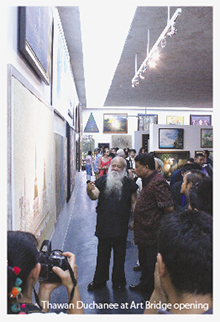 “Chiang Rai artists had been wanting to create a museum for 20 years, but nothing happened,” explained Tomako as we browsed through the gallery. “I think government people can’t quite understand art or grasp the need for it. So we had to do it ourselves.”
“Chiang Rai artists had been wanting to create a museum for 20 years, but nothing happened,” explained Tomako as we browsed through the gallery. “I think government people can’t quite understand art or grasp the need for it. So we had to do it ourselves.”
And do it they did, thanks to a generous donation of 500,000 baht from Chalermchai Kositpipat, who in addition to the White Temple has designed several other elaborate fixtures around town, including a gleaming gold clock tower in the centre of town that lights up in discotheque colours every hour after dark (or rather, until nine o’clock, mercifully enough for its neighbours).
“This was our start,” said Sompong Sarasap Saowanee, owner of Chiang Rai’s 9 Art Gallery and Architect Studio, and another member of the arts committee that spearheaded the Art Bridge project. “With this money our scale broadened, and we were able to get the project off the ground. Then we decided to make it a collective so that the artists and the public can invest what they can and have a sense of ownership as a result.”
Indeed, the Art Bridge is a communal endeavour, which means that anyone can contribute and own a little piece of the pie. Shares cost only 1,000 baht each, and a single person can purchase up to 500 shares. Shareholders receive partial ownership in the project with the possibility for a return on their investment if things go well over the next few years. Nearly 200 people have already contributed 6.2 million baht so far, but more is still needed to reach the committee’s final goal. As such, shares are still available for both artists and non-artists alike who are interested in taking part.
At the event, I spoke with a local hotel owner and shareholder named Bett. “Even though I’m not an artist, I feel like I have an artist’s mind and heart,” he told me. “I support the arts, which is why I got involved. Locals are a very important part of building an art community.”
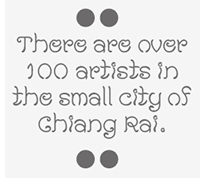 Must Love Art
Must Love Art
This was a common theme throughout the evening: the uncommon amount of respect that the people of Chiang Rai have for the arts, and their local artists.
“We have idols here that people aspire to, endless inspiration,” Somluck explained. “I think likeminded people are attracted to Chiang Rai because we have a creative culture already, both contemporary and historical. Also, we have the beauty of nature – rivers and mountains that make people more sensitive and creative. People respect artists in Chiang Rai. They want them to thrive. This is our home.”
American expat and artist Lisa Moses and her art-loving husband Danny, who visited Chiang Rai from Los Angeles for the first time in 2001 before returning to settle permanently in 2006, agree. “The art scene here is wonderful and the people are so warm,” said Lisa. “I’m inspired by the beauty of it, and the fact that you can walk down the street and say hello to people.”
This much was clear; as the evening wore on we continually noticed the palpable sense of closeness and friendliness between all the attendees. All three nationally renowned artists stayed throughout, sitting down together for a meal and engaging warmly with their fans. It was not the austere, rather pretentious environment that I’ve come to expect from nationally-recognised art openings in the West. Rather, it felt like one big family at a communal housewarming party, and that’s pretty much exactly what it was.
“There are over 100 artists in the small city of Chiang Rai,” said Tomako. “They needed a place to show their work, and to make that happen we needed community support. I guess the atmosphere was ripe, it was the right idea at the right time. It’s amazing, the support that came. Not only from Chiang Rai but also Chiang Mai and Bangkok and even internationally. This is a bridge that extends everywhere.”
Here to There:
The trip from Chiang Mai to Chiang Rai is an simple one, with several different travel options to choose from.
Green Bus
Cheap and easy. Tickets must be purchased at a bus station or travel agency.
(www.greenbusthailand.com)
Boat from Ban Thaton
The Mae Kok Boat Service Company in Ban Thaton, Chiang Mai runs a Thaton-Chiang Rai boat service with departures every day at 12.30 pm. The trip takes approximately three hours and there are many sights along the way.
(www.chiangmai-chiangrai.com/mae_kok_river_boat_trip.html)
Plane
The quickest option is also, of course, the most expensive, but we hear it’s quite a scenic flight.
(www.kanairlines.com/web)
Own transportation
Hop into your car or motorbike and head north on Rt. 116 for about two hours, then take Rt. 1 another half hour and boom! You have arrived.
(www.maps.google.com)
